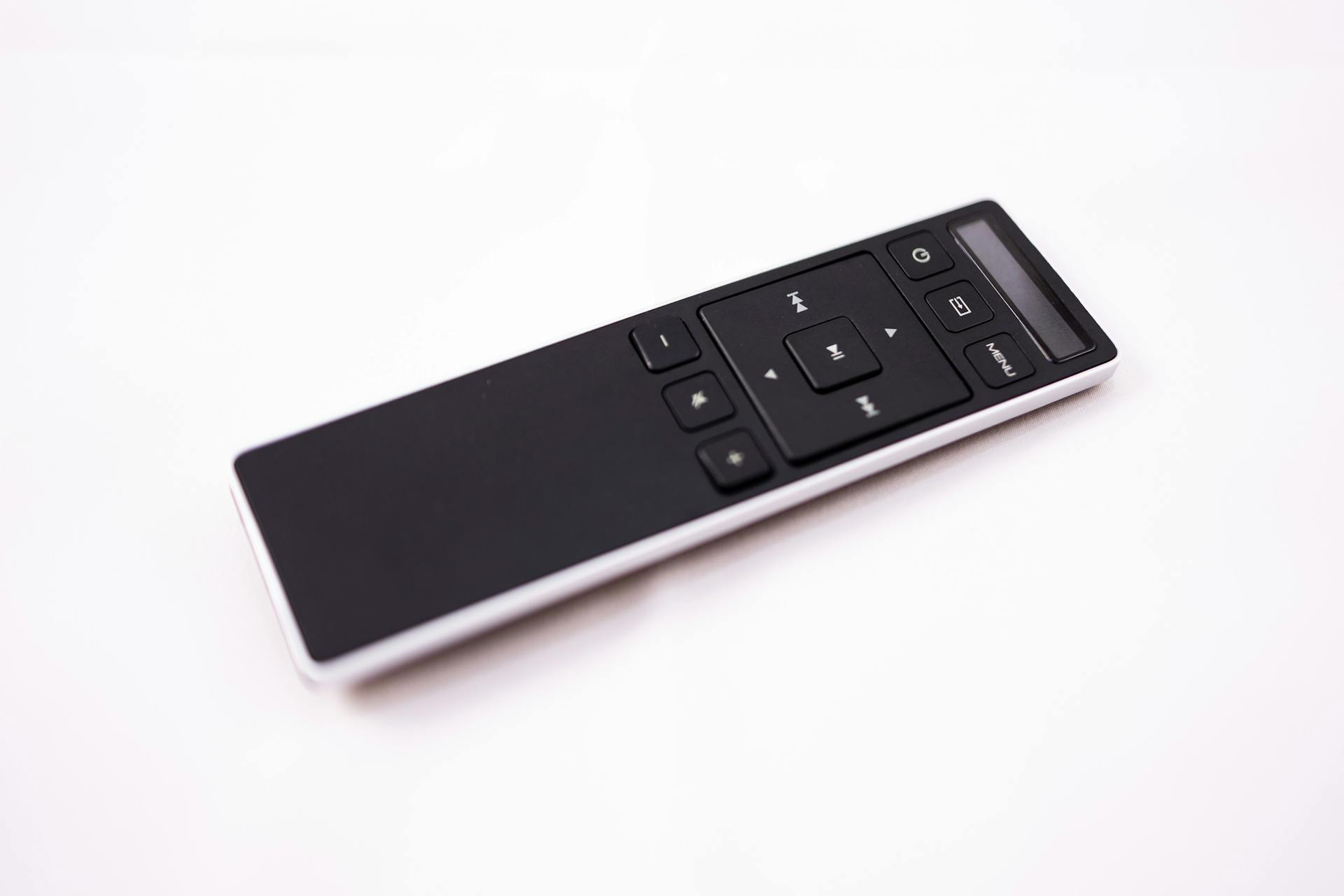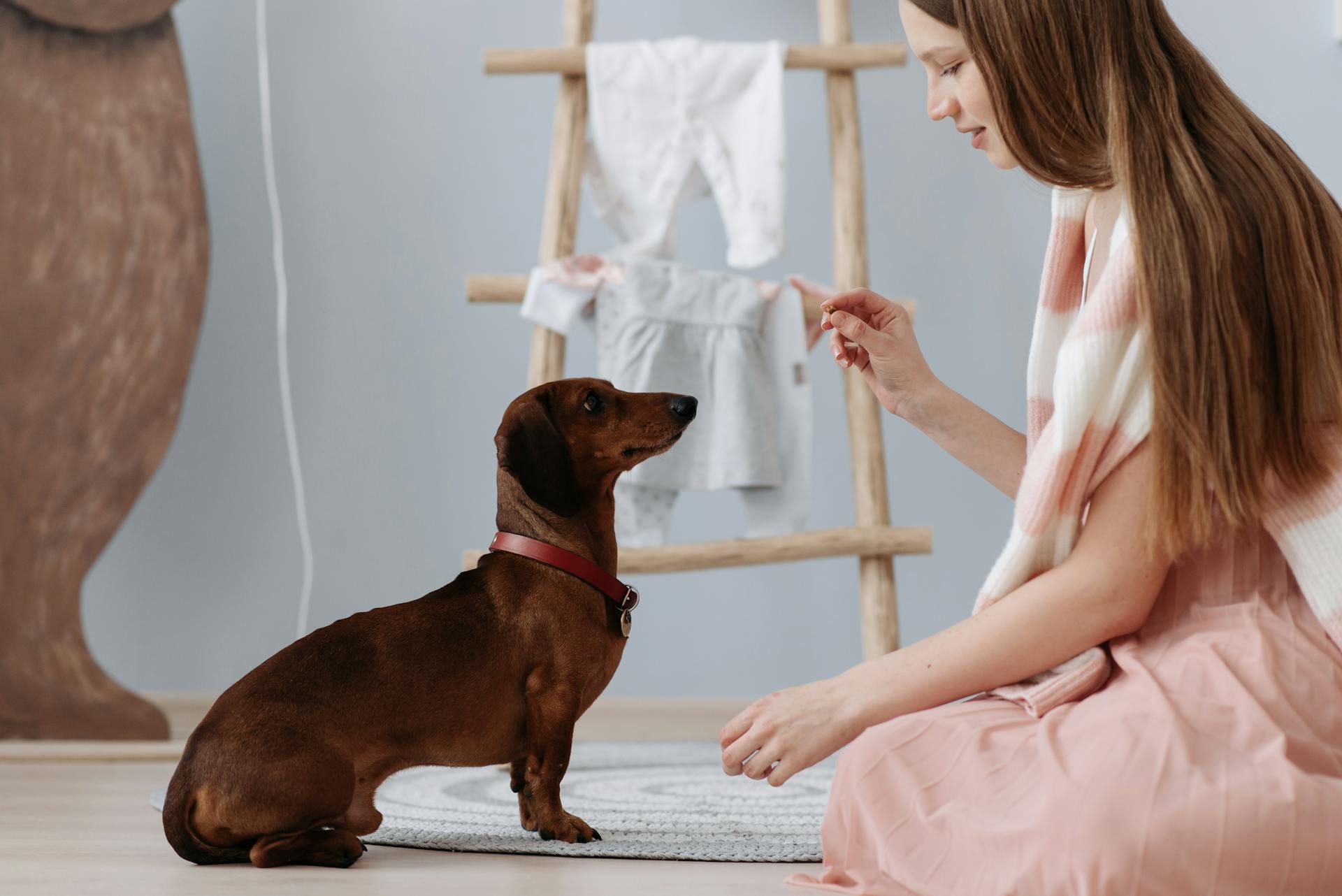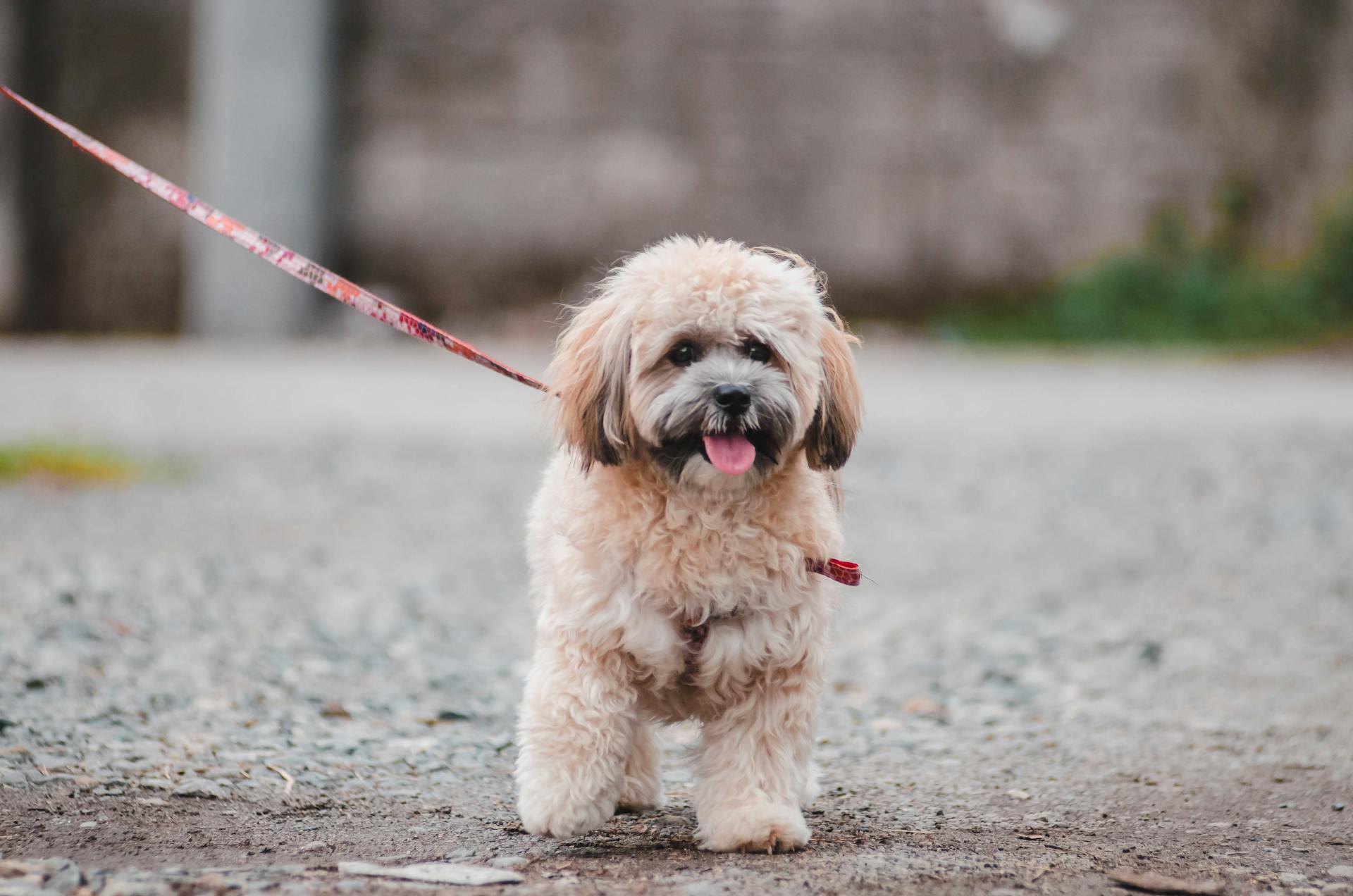
The dog training clicker is a powerful tool that can help you communicate effectively with your furry friend. It's a small device that makes a distinct sound when pressed, and it's used to mark good behavior and reinforce positive actions.
The clicker is not a punishment tool, but rather a way to reward your dog for desired behaviors. By associating the sound with a treat or praise, your dog learns to associate the click with something good.
A well-placed click can be incredibly effective, but it's essential to use it correctly. The sound should be immediate and consistent, so your dog can make the connection between the behavior and the reward.
With patience and practice, you can use the clicker to teach your dog a wide range of skills, from basic obedience to complex tricks.
You might enjoy: It's Your Choice Dog Training
What Is a Clicker?
A clicker is a small device that makes a distinct sound, typically a "click", when pressed. This sound is designed to be attention-grabbing and easily recognizable by dogs.
Worth a look: Dog Training Sounds
The sound is usually a sharp, crisp noise that can be heard clearly in various environments. It's often compared to the sound of a camera shutter or a small metal object being snapped shut.
The clicker is used in conjunction with treats and rewards to reinforce desired behaviors in dogs. In the article, we'll explore how to use a clicker effectively in dog training.
Basic Commands
Teaching your dog basic commands is a great place to start with clicker training. The clicker is an incredibly accurate tool that helps your dog associate its actions with rewards.
To get started, press the clicker at the exact moment your dog performs the desired action. This is crucial for clarity and prevents confusion.
The clicker's accuracy is one of its best features, allowing your dog to understand what it's doing and increasing the likelihood of it repeating the action in the future.
Consider reading: Why Use a Clicker for Dog Training
Click Meaning
The clicker is just a tool to mark a moment, not a magical noise that holds special meaning for your dog.
You can substitute anything as a marker as long as it's distinct from other ways you communicate with your dog, such as snapping your fingers, blowing a whistle, or clucking your tongue.
The click itself is meaningless until it's paired with a reward, so make sure to follow it up with something your dog values, whether it's a treat or a game of tug-of-war.
Timing and consistency are key, so the click must mark the correct moment and every click must be followed by a reward.
For a hearing-impaired dog, you could use a light or a gentle tap on the shoulder as a marker instead of the clicker.
The reward itself is what gives the click meaning, not the click itself, so experiment with different rewards to find what motivates your dog best.
You might like: Reward Based Dog Training
Stay
Teaching your dog to stay is a crucial command that requires patience and consistency. Start by making the click sound every few seconds as long as it doesn't move.
Begin with short intervals, aiming for 10 seconds, and gradually increase the time during each training session. Try to work up to holding the position for five minutes.
It's essential to reward your dog for staying in position, so be sure to give it a treat or praise when it successfully holds still.
For more insights, see: Dog Training Position Box
Training Methods
Clicker training is a precise technique that relies on timing to deliver the conditioned reinforcer at the same moment as the desired behavior. This is the basis of effective clicker training.
The first step in clicker training is teaching your dog to associate the clicker noise with a treat. Simply press the clicker, give your pooch a treat, and repeat. After 10 to 20 repetitions, your dog will understand that the sound of the click means a reward is about to come.
There are three main types of training that the clicker is particularly useful for: Lure and reward training, Shaping behavior, and Capturing behavior. These methods are used to teach new behaviors, shape existing ones, and reinforce good behavior.
- Lure and reward training: This involves using a treat to lure your dog into performing desired behavior, such as sitting or rolling over.
- Shaping behavior: This involves rewarding smaller steps of a larger, new behavior, such as laying down or walking on a leash.
- Capturing behavior: This involves noticing your dog doing something well and rewarding them for it, such as sitting in their bed instead of begging at the dinner table.
Precise timing is crucial in clicker training, as it helps your dog understand exactly what they did well. By delivering the conditioned reinforcer at the same moment as the desired behavior, you can help your dog learn quickly and efficiently.
Using Rewards
Clicker training is not meant to completely replace the use of treats. The sound of the click instantly tells the dog that what it has done will earn it a reward.
Use strong rewards a lot during initial training stages, and treats are often the strongest reward for a dog. For an easy, low-cost option, use small pieces of unseasoned cooked turkey or chicken during your training.
You should frequently be followed by treats, otherwise the clicker will lose its effectiveness. After about 10–20 repetitions, your dog will understand that the marker predicts a coming reward.
Use smaller but still enticing treats that your dog enjoys, and provide intermittent treats now and then. The clicker should be the main source of communication.
Click, then immediately treat to pair your chosen marker with a reward. You can use your marker with lure-and-reward training, where you use a reward to lure your dog into the behavior you’re looking for.
It’s good to provide treats less frequently and use the clicker as the primary reward. The clicker should be the main source of communication.
You might enjoy: What Treats to Use for Dog Training
Training Sessions
During training sessions, it's essential to use the clicker effectively to communicate with your dog. You should start by using treats in addition to the sound of the clicker to get your dog's attention.
The first step in using the clicker is to "load" it, which means teaching your dog to associate the clicker noise with a treat. Press the clicker and give your dog a treat, repeating this process 10 to 20 times until they understand the connection.
Use the clicker in conjunction with lure-and-reward training, where you use a treat to lure your dog into the desired behavior. For example, if you're teaching your dog to sit, hold a treat above their head and click the clicker when they sit.
Shaping behaviors involves rewarding smaller steps of a larger behavior. Click and offer a treat when your dog lays down, for instance, and eventually they'll start trying other behaviors to figure out what you're looking for.
Related reading: Dog Treat Training
You can also use the clicker to capture good behavior, such as when your dog lies quietly on a mat instead of begging at the table. Click and reward that behavior to reinforce it.
Here are three types of training that the clicker is particularly useful for:
- Lure and reward training: This involves using a treat to lure your dog into performing a desired behavior.
- Shaping behavior: This involves rewarding smaller steps of a larger behavior.
- Capturing behavior: This involves noticing your dog doing something well and rewarding them for it.
As you continue to use the clicker, you can gradually phase out the treats and use the clicker as the primary reward. Provide intermittent treats to keep your dog engaged, but make sure the clicker is the main source of communication.
If this caught your attention, see: Pecole Dog Training Collar How to Use
Advanced Training
Clicker training can be a game-changer for advanced training, allowing you to be hands-off and focus on delivering rewards. You simply click for small steps toward the behavior and work the dog toward the final, completed behavior.
The clicker is a very valuable tool in the training process. It helps your dog understand exactly what they did well and makes it more likely they'll repeat it in the future.
To get started with advanced clicker training, you'll want to teach your dog to associate the clicker noise with a treat. This is done by pressing the clicker, giving your pooch a treat, and repeating this process 10 to 20 times.
There are three types of training that the clicker is particularly useful for:
- Lure and reward training: This involves using a treat to lure your dog into performing desired behavior, such as holding a treat above their head to teach a sit.
- Shaping behavior: This involves rewarding smaller steps of a larger, new behavior, such as clicking and treating your dog for laying down when trying to teach a roll over.
- Capturing behavior: This involves noticing your dog doing something well and rewarding them for it, such as clicking and treating your dog for sitting in their bed instead of begging at the dinner table.
By using the clicker in these ways, you can help your dog understand what they're doing right and make the training process more efficient and effective.
Frequently Asked Questions
What are the disadvantages of clicker training?
Clicker training can be challenging for dogs with low motivation and may not lead to consistent behavior if not done correctly. It also requires a significant amount of knowledge, practice, and coordination to master more complex tricks.
Do dogs learn faster with clickers?
Research suggests that clicker training can be effective for teaching new behaviors to dogs, but its effectiveness is comparable to using food rewards alone. Clicker training may be worth exploring for dog owners, but it's essential to understand its limitations and potential alternatives.
Does a dog clicker stop barking?
Yes, a dog clicker can help stop barking by teaching your dog a new behavior to replace the barking. With consistent training and positive reinforcement, you can train your dog to be quiet on command.
Can you use a clicker to stop bad behavior?
Yes, clicker training can be effective in stopping unwanted behaviors, such as excessive barking, by associating the behavior with an undesirable outcome. Learn how to use a clicker to modify your dog's behavior and achieve a more peaceful living environment.
Sources
- https://www.thesprucepets.com/clicker-training-for-dogs-1118267
- https://www.akc.org/expert-advice/training/clicker-training-your-dog-mark-and-reward/
- https://en.wikipedia.org/wiki/Clicker_training
- https://thedogwizard.com/blog/how-to-use-a-clicker-for-dog-training/
- https://www.pumpkin.care/blog/clicker-training-for-dogs/
Featured Images: pexels.com

